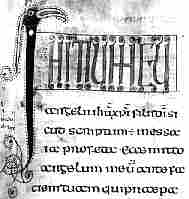
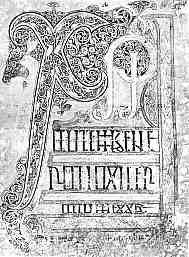

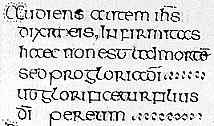

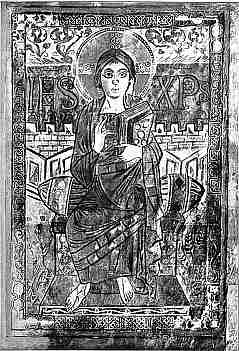
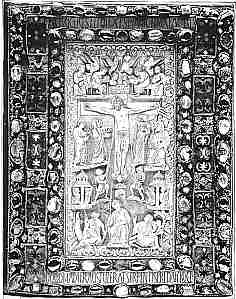

If you are looking at this page without frames, there is more information about medieval writing to be found by going to the home page (framed) or the site map (no frames).
| Early Bibles and Gospels (4) | |||||
| The segment at right shows a sample from an early 8th century gospel book. It was probably written at Lindisfarne. The peculiar script of the heading is suggestive of this. The main script of the text is insular half uncial. However, although there are some decorative headings, as here, it is nowhere near as elaborate as its better known cousin. It probably represents the kind of gospel book that was in more regular use for daily readings, and of which hundreds of examples have most likely disappeared over time. |
 |
||||
| Early 8th century gospel (British Library, Royal 1 B VII, f.55). By permission of the British Library. | |||||
 |
Indicating the problems of tracing developments of style and influence with so few surviving examples, the Gospels of St Chad, now in Lichfield Cathedral, bear many resemblances in script and decoration, including the strange heading script, to the more famous Lindisfarne Gospel and to the Book of Kells. It is actually of Welsh origin, or at least it belonged to the church of Llandaff. Perhaps the Welsh nationalists can join in the fray to claim this aspect of the cultural patrimony. | ||||
| Chi-Rho page from the Gospels of St Chad (Lichfield Cathedral, Library, p.5). (From E.G. Millar 1923 The Lindisfarne Gospels London: British Museum.) (Click on image for a larger version.) | |||||
| Occasionally, these tomes survive only in fragmentary form. | |||||
 |
|||||
| A few lines of text from an imperfect and disarranged gospel (Durham Cathedral Library, MS. A. II. 17, f.51). (From The New Palaeographical Society 1904) | |||||
| The script of the above example, from the 8th century, greatly resembles that of the Book of Kells. | |||||
 |
One sample of script from another 8th century gospel (Durham Cathedral Library, MS. A. II. 16, f.121). (From The New Palaeographical Society 1905) | ||||
| The above sample is from another imperfect and disarranged gospel book; so disarranged that some of it is in Durham Cathedral Library and some other leaves are in Magdalene College, Cambridge. The script changes from uncial at the beginning of Matthew to two different forms of insular half uncial as the volume contained not only different scribal hands, but different script types. | |||||
| The insular system of scripts seems to have had a touch of class about it, so that half uncial and even minuscule forms were suitable for the most sacred book of Christendom. The many minuscule scripts which evolved on the continent of Europe, often inappropriately dubbed the National Hands, were used for commentaries, epistles, martyrologies and all the other literary necessities of the early church, but do not seem to have been extensively used for the Bible itself. The most sacred book required the formality of uncial script. | |||||
 |
|||||
| Segment from across the page of a mid 8th century gospel (Autun, Bibliothèque du grand Seminaire, 3). (From Steffens 1929) | |||||
| In the above example, the text in the left hand column, part of the gospel of St John, is in uncial script while that of the right, a commentary on the text, is in Merovingian minuscule. | |||||
| The changes which took place in monastic libraries in the Carolingian era saw more accurate transcriptions of St Jerome's Vulgate text made. Some surviving volumes have fine illustrations, drawing anew from the Classical tradition, while a very few examples have highly elaborate works of art as covers, indicating that these were the very special volumes valued as objects as well as texts. | |||||
 |
 |
||||
| At left, a figure of Christ from the Godesscalc Evangelary (Bibliothèque Nationale, ms. n. acq. lat. 1203, f.3r), at right the jewelled and ivory cover of the Metz Evangelary (Bibliothèque Nationale, MS. Lat. 9383). | |||||
| Not only was the text reformed, but the new, neat and clear Caroline minuscule script meant that text could be packed more closely into pages while still remaining legible. Furthermore, the code of legibility of this new script spread across the religious communities of Europe. Minuscule script became sufficiently valued to be able to be used for the most sacred book of all. |
 |
||||
| The Ada Gospels of the late 8th century (Treves, Stadtbibliothek, Bibelhandschriften 22 (Codex aureus), p.17). (From Steffens 1929) | |||||
| This process of standardisation of the primary sacred text can be seen to coincide with a change from monastic communities as missionary outposts in barbarian societies, to a strong and connected series of communities which were recreating the cultures of Europe. It took a long time, and there were some serious setbacks along the way, but the process was started. | |||||
|
|
|||||
|
|
|||||
|
|
|||||
|
If you are looking at this page without frames, there is more information about medieval writing to be found by going to the home page (framed) or the site map (no frames). |
|||||